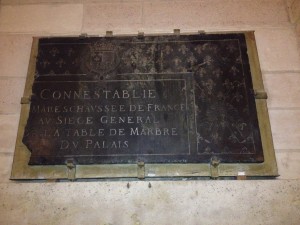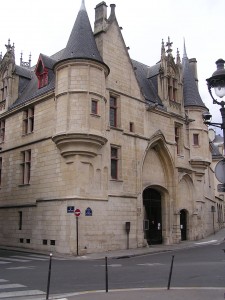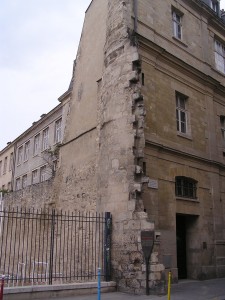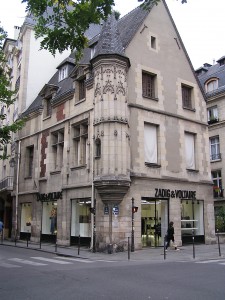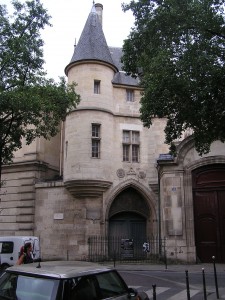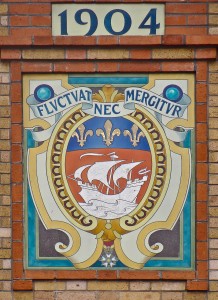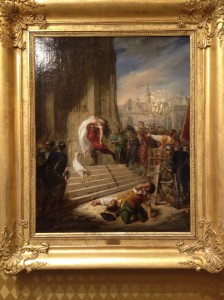
Quasimodo rescues La Esmeralda, a painting that belonged to Hugo himself. He deplored the misleading title given to many English editions of his book - 'The Hunchback of Notre-Dame'
Victor Hugo’s strange, brilliant, early novel, Notre-Dame de Paris: 1482 (published in 1831), is a literary curiosity, in which sensational melodrama is combined with searing polemic. Hugo’s target is the prevailing opinion that scorned the remaining monuments of Gothic architecture and readily acquiesced in their destruction.
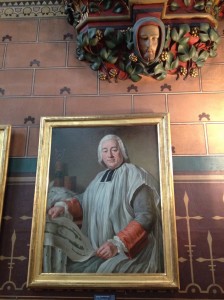
The carved figure above - by Viollet-le-Duc - is more like the sinister Frollo of the novel than the real-life Canon Guillot de Montjoye of the painting
The ‘eye of the novel’, the Cathedral of Notre-Dame itself, was in a pitiful state of neglect; Robert Louis Stevenson described it as an ‘old church thrust away into a corner’ (Familiar Studies of Men and Books, London, 1917, pp.11-12). It was certainly not appreciated as a Gothic masterpiece. ‘In the minds of progressive Parisians,’ writes Hugo’s biographer, ‘it was a shabby relic of the barbarian past.’ (Graham Robb, Victor Hugo, London, 1998, p.158) The style of the book is as ‘Gothic’ as the architecture it praises, ‘a style that had long been under a cloud in France, from which it took Romanticism to save it … The novel is thus meant in part as a redemption of an architecture in eclipse’ (John Sturrock, introduction to the Penguin Classics edition of Notre-Dame de Paris, London, 2004, pp.16, 17).
The strength of Hugo’s feeling is best expressed in a fiery pamphlet from about that time entitled War on Demolishers!, in which he deplores the plan of a municipal council – that of Laon – to demolish one of its landmarks, a medieval tower: ‘It took the nineteenth century, the marvels of progress! A goose quill, drawn more or less at random across a sheet of paper by a few infinitely insignificant men! The miserable quill of a fifth-rate town council! A quill that haltingly draws up the idiotic dictates of a peasant divan! The imperceptible quill of the Lilliputian senate! A quill that makes mistakes in French! …’ (trans. Sturrock, introduction to Notre-Dame de Paris, p.19). As the historian of Basingstoke, I am myself keenly aware of the devastation that can be wrought on a community and a landscape by the arbitrary decisions of pygmies and philistines, especially when justified in the name of ‘progress’. The famous tower of Laon, like the historic heart of Basingstoke, was inevitably reduced to a pile of rubble.
Poor Hugo was subsequently forced in his long life to witness the almost wholesale destruction of the medieval fabric of Paris, and a restoration of his beloved Notre-Dame (by Lassus and Viollet-le-Duc) that veers on pastiche. Yet the lost city is to some extent preserved in his novel, in which he so convincingly evokes the ‘inextricable web of bizarrely twisted streets’ and the life that went on in them.
What, then, remains of medieval Paris and the locations of Hugo’s novel? The vast Grande Salle of the Royal Palace, scene of the novel’s energetic opening chapter, has disappeared, but the equally vast lower hall beneath it, the Salle des Gens d’Armes, is preserved intact as the bowels of the Conciergerie, a place haunted by its associations with the Revolution. Also preserved are the two impressive towers that guard the entrance to the building. It is in the Grande Salle that Pierre Gringoire is to stage his play on ‘the famous slab of marble’ at one end of the room (p.35), that served the king as a table dormant. A fragment of this, strewn with fleurs-de-lys, hangs on the wall of the Salle des Gens d’Armes.
The medieval layout, and a few medieval buildings, are to be found across the river in the Marais. In the rue du Fauconnier, one can visit the Hôtel de Sens, newly constructed in 1482. During his harrowing childhood on the streets of Paris, the porch of this building was the resort of the homeless, shoeless, orphaned Gringoire, who would huddle under it and attempt to warm himself in the winter sun (trans. Sturrock, p.120).
Nearby, only the imprint remains of the ‘immense, multiform enclosure of the miraculous Hôtel de St Pol, where the King of France had the wherewithal to lodge in great splendour twenty-two princes of the rank of the dauphin or the Duke of Burgundy, together with their domestics and retinues’ (trans. Sturrock, p.142). Unimaginatively redeveloped in the 1970s, it is a curious complex – deserted, forlorn, atmospheric – marked by such oddities as a shop purveying antique erotica.
Just across the rue des Jardins, however, a significant portion of the city walls of Philip Augustus – already redundant in 1482, and falling into ruin – forms the boundary to a school yard, with, at one end, the scant remains of one of the ‘huge old towers of the ancient walls of Paris’, to which one of Hugo’s characters alludes:
‘My dear Colombe,’ put in Dame Aloïse, ‘do you mean the hotel that belonged to Monsieur de Bacqueville, in King Charles VI’s days? There are indeed some magnificent high-warp tapestries there’ (trans. Sturrock, p.249).
Further north, on the rue des Francs Bourgeois, one encounters a real curiosity, not strictly medieval but dating from within a few decades of Hugo’s story – the tall, turreted Hôtel Hérouet, on the corner with the rue Vieille-du-Temple, built for the royal treasurer Jean Hérouet in the early 1500s. There is now a draper’s shop on the ground floor, and original features such as fireplaces are not visible.
Most evocative to me is the gatehouse to the Hôtel de Clisson in the rue des Archives, built in the 1380s for the Constable Olivier de Clisson, companion in arms of Bertrand du Guesclin (and later, as the Hôtel de Guise, home to the mother of Mary, Queen of Scots).
It is to the Île de la Cité, the historic and actual heart of Paris, that one must always return. To the pioneering heralds of the reign of Philip Augustus, the island resembled a great ship that had somehow been stranded in the middle of the Seine, with its stern to the east and its prow to the west. Moreover, its five bridges (each of them lined with houses) seemed to moor this vessel to the two opposing banks. The great cathedral church of Notre Dame, the true heroine of Hugo’s story, was at the stern end of the ship.
Hence – as Hugo points out, the inclusion of a ship in the city’s coat of arms – Gules, on waves of the sea in base a ship in full sail argent, a chief azure semé-de-lys or (illustrated here on a public building in the 5th arrondissement). ‘For those who can decipher it,’ he writes, ‘blazonry is an algebra, a language. The whole history of the second half of the Middle Ages in written in blazonry’ (trans. Sturrock, p.136). Incidentally, the last bridge to be lined with houses, one of which plays a significant part in the story, was sadly felled in Hugo’s lifetime.
